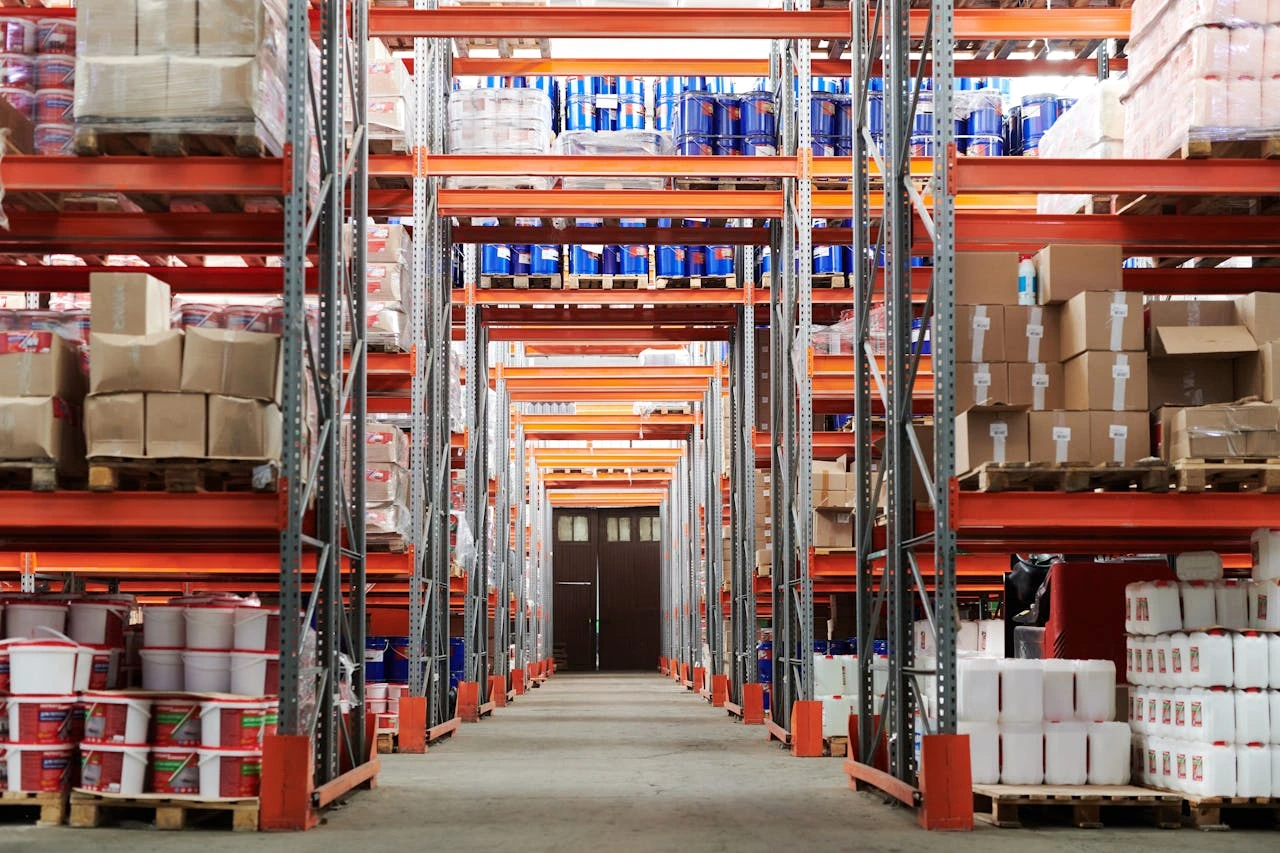Warehouse logistics stands as the backbone of efficient, streamlined operations in supply chain management. From inventory accuracy to speed of order fulfillment, a robust logistics strategy inside a warehouse gurantees that every cog in the machine operates in perfect harmony.
In this comprehensive guide, we discuss the technologies, strategies, and best practices in warehouse logistics for supply chain optimisation.
What is Warehouse Logistics?
Warehouse logistics refers to the management of operations within a warehouse from receiving goods and storing them securely to picking, packing, and shipping them to customers or retailers. It involves coordinating space, equipment, labour, and processes to optimise efficiency, reduce costs, and maintain high service levels.
Complete Project Logistics Starts Here! From warehousing and packaging to customs and chartering, JCS Projects manages every step. Let us help you launch your project the right way. Get a quote!
Benefits of Warehouse Logistics in Supply Chain Optimisation
Effective warehouse logistics play a critical role for smoothly running supply chain operations. Below are some of the key benefits businesses can gain by focusing on warehouse logistics::
Improved Inventory Management
Accurate tracking systems and inventory controls help maintain optimal stock levels, reducing the risk of overstocking or running out of essential items.
Faster Order Fulfillment
With streamlined picking, packing, and shipping processes, orders are fulfilled more quickly, leading to better customer experiences and repeat business.
Cost Efficiency
Optimising warehouse operations helps cut down on wasted space, time, and labour costs, ultimately reducing overhead and increasing profit margins.
Better Space Utilization
Efficient warehouse layouts and storage systems make the most of available space, allowing for smoother operations and room for growth.
Enhanced Customer Satisfaction
Reliable, on-time deliveries with fewer errors boost customer trust and satisfaction, key drivers of long-term success.
Greater Supply Chain Visibility
Real-time tracking and data analytics provide insights into inventory, demand, and performance, improving planning and responsiveness.
Reduced Errors and Returns
Automation and accuracy in picking and packing reduce mistakes, which means fewer returns and less disruption to operations.
Scalability and Flexibility
A well-managed warehouse can quickly adapt to seasonal spikes, market changes, or business growth without sacrificing efficiency.
Key Components of Effective Warehouse Logistics
Understanding the key components of effective warehouse logistics is important for streamlining warehouse operations and supply chain optimisation.
1. Inventory Management
Effective inventory management ensures that the right products are available at the right time. It involves:
- Real-time inventory tracking
- Automated replenishment
- Cycle counting and physical audits
- SKU rationalisation
Using advanced Warehouse Management Systems (WMS), businesses can monitor stock levels, forecast demand, and reduce carrying costs.
2. Receiving and Putaway
This critical function includes unloading goods, inspecting them, and storing them in their correct locations. Efficient receiving processes:
- Minimise unloading time
- Keep goods damage-free
- Update inventory systems instantly
- Use barcode and RFID scanning for accuracy
Putaway processes should be strategically planned to minimise travel time and maximise storage utilization.
3. Storage Optimisation
Warehouse layout plays a significant role in maximising space efficiency. Key storage systems include:
- Pallet racking
- Shelving
- Mezzanine floors
- Automated storage and retrieval systems (AS/RS)
Dynamic slotting techniques help assign optimal storage locations based on product velocity and handling requirements.
Looking for a logistics partner? We provide warehousing, transport engineering, and turnkey transport solutions tailored to your sector, whether it's oil & gas, construction, or energy. Call us now +44(0)1753 687 722.
Order Fulfillment and Picking Techniques in Warehouse Logistics
These are the key order fulfillment and picking techniques used in warehouse logistics:
1. Picking Methods
Accurate and fast picking directly impacts customer satisfaction. Common picking strategies include:
- Batch picking: Picking multiple orders in one run.
- Zone picking: Workers assigned to specific warehouse zones.
- Wave picking: Coordinated picking and shipping schedules.
- Voice picking: Voice-guided systems for hands-free efficiency.
Combining these techniques with mobile scanning devices supports high accuracy and productivity.
2. Packing and Shipping
After picking, items are consolidated, packed securely, and labeled for dispatch. Efficient packing involves:
- Minimising packaging waste
- Keeping product protection
- Automating weight and dimension checks
- Using multi-carrier shipping software
This process promotes smooth coordination with last-mile delivery partners and enhances delivery accuracy.

Technology and Automation in Warehouse Logistics
Technology and automation are the cornerstone of today’s warehouse logistics solutions, enhancing overall logistics operations and strengthening the supply chain.
1. Warehouse Management Systems (WMS)
A modern WMS provides:
- Real-time visibility
- Intelligent routing
- Automated reporting
- Integration with ERP and TMS platforms
Leading systems like SAP EWM, Oracle WMS, and Manhattan Associates provide scalability and deep integration.
2. Internet of Things (IoT) and Sensors
IoT-enabled devices track:
- Asset location
- Temperature and humidity (for perishables)
- Equipment utilization
- Real-time alerts for stockouts or maintenance
3. Robotics and Automation
From Autonomous Mobile Robots (AMRs) to automated guided vehicles (AGVs) and conveyor systems, automation:
- Reduces labour costs
- Increases picking speed
- Enhances safety
- Allows for 24/7 operations
Collaborative robots (cobots) are increasingly used to assist human workers in repetitive or heavy-lifting tasks.
Labour Management and Safety in Warehouse Logistics
The safety and well-being of workers are a top priority in efficient warehouse logistics and supply chain optimisation. Here are some of the points to note:
1. Workforce Planning
Warehouse logistics relies heavily on a skilled and responsive workforce. Using Labour Management Systems (LMS) can help:
- Track individual productivity
- Forecast workforce needs
- Balance workloads across shifts
2. Training and Compliance
Ongoing training in equipment handling, safety protocols, and emergency response enhances regulatory compliance and mitigates risk.
3. Health and Safety Measures
Implementing safety best practices such as:
- Clearly marked zones
- Regular equipment maintenance
- Ergonomic workstations
- PPE availability
By implementing these practices, companies can significantly reduce workplace accidents and improve operational uptime.
Layout and Design in Warehouse Logistics
A well-planned warehouse layout and design are crucial for smooth operations. Here are some essential tips to get it right:
1. Efficient Floor Planning
A well-planned layout considers:
- Material flow
- High-turnover item placement
- Storage density vs. accessibility
- Dock door locations
Designing with scalability in mind allows for future growth without major structural changes.
2. Lean Warehousing
Lean principles aim to eliminate waste (time, movement, excess inventory) and promote continuous improvement. Common lean tools include:
- 5S (Sort, Set, Shine, Standardise, Sustain)
- Kaizen (continuous improvement)
- Value stream mapping
Our expert project cargo team is ready to move your most difficult shipments on time, safely, and securely. No matter the challenge, we are always available for help.
Performance Metrics and KPIs for Supply Chain Optimisation
Tracking key performance indicators (KPIs) is essential for continuous supply chain optimisation. Crucial KPIs include:
- Order accuracy rate
- Inventory turnover
- Dock-to-stock time
- Picking productivity
- Cycle count accuracy
- On-time shipments
Using dashboards and analytics tools helps identify bottlenecks and improve overall efficiency.
Sustainability in Warehouse Logistics
With rising environmental concerns, many warehouses are integrating eco-friendly practices, such as:
- Energy-efficient LED lighting
- Solar-powered warehouses
- Electric forklifts
- Recyclable packaging materials
- Green certifications (LEED, ISO 14001)
Sustainable operations reduce carbon footprints and enhance brand reputation.
Challenges in Warehouse Logistics and How to Overcome Them
Warehouse logistics can encounter several operational hurdles that impact efficiency and customer satisfaction. Understanding these challenges is the first step toward implementing effective solutions.
1. Labour Shortages
Solution: Invest in automation, improve working conditions, and provide incentive-based training programs.
2. Inventory Inaccuracy
Solution: Use real-time tracking, RFID systems, and conduct frequent cycle counts.
3. High Operational Costs
Solution: Optimise space utilization, energy consumption, and route planning.
4. Seasonal Fluctuations
Solution: Adopt flexible staffing, use temporary storage solutions, and enhance forecasting models.
Future Trends in Warehouse Logistics
- Artificial Intelligence (AI) for predictive analytics
- Digital twins to simulate and optimise operations
- Blockchain for transparent and secure transactions
- Omnichannel fulfillment strategies
- Drone deliveries and aerial inventory monitoring
Staying ahead of these trends helps your warehouse logistics strategy stay agile and future-proof.
Ready to Streamline Your Warehouse Logistics and Project Cargo Needs?
At JCS Projects, we specialise in turning complex logistics challenges into seamless solutions. Whether you’re managing oversized cargo like wind turbine blades, time-sensitive oil and gas equipment, or intricate warehouse operations, our decades of experience and global network offer precision, efficiency, and reliability.
Why Choose JCS Projects?
- Expertise in Tough Terrains: From remote offshore rigs to urban warehouses, we handle the awkward, the heavy, and the hazardous with ease.
- Turnkey Solutions: Comprehensive services from route surveys and customs clearance to warehousing, export packaging, and door-to-door project management.
- Proven Success: Trusted for high-stakes projects like chartering AN124s for helicopters and shipping 1 million kilos of power station materials.
Take the Next Step
Ready to optimise your warehouse logistics or tackle your next big project? Contact our team today for personalised consultation and innovative solutions tailored to your needs.
📞 Call us at +44(0)1753 687 722
📧 Email us at: projects@jamescargo.com
Key Takeaways
A fully optimised warehouse logistics system is vital to meeting the growing demands of eCommerce, global trade, and modern consumers. From advanced automation and lean practices to smart software and predictive analytics, mastering warehouse logistics is not a one-time project, it's a continuous commitment to excellence and innovation.
Recommended topics:
